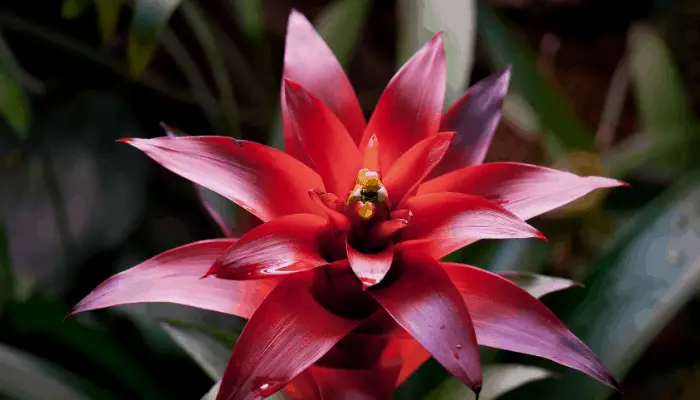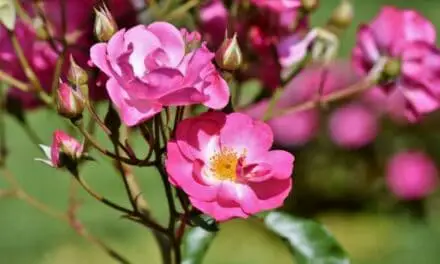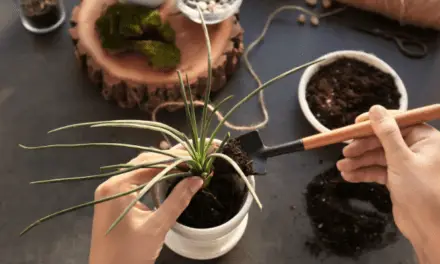Bromeliads make for a popular houseplant because they are tough, easy to maintain, and have stunningly colorful blooms.
However, a common problem that arises for many who keep these, is that their vibrant color begins to change.
Table of Contents
Why Is My Bromeliad Losing Its Color?

The most common reasons your bromeliad may be losing its color are over or underwatering, over or under exposure to sunlight or the plant may have flowered and is now dying.
Let’s take a closer look at some of the most common reasons for this change in color and what you should do.
Watering Issues
Bromeliads will begin to lose their color if they are not being watered properly.
They usually don’t require much water to do well and overwatering can cause a lot more damage than underwatering.
Don’t be afraid to underwater your bromeliad as it can recover much faster from being too dry than it can from being too wet.
As a general rule, water your bromeliad deeply and then allow its soil to dry out completely before you water it again.
This type of plant does not like to be waterlogged so it is important to use well-drained soil as your potting mix.
Related Article: Why Are My Bromeliad Leaves Splitting?
Over Exposure To Sunlight
If your bromeliad gets too much strong, direct sunlight, it will scorch, develop brown spots, and the tips of its leaves will begin to turn brown.
Don’t plant it outside if it’s fully exposed to the summer sun and don’t leave it on a window sill where it will get too much direct sunlight.
Bromeliads usually live on the rainforest floor where they receive lots of indirect, filtered light through the forest canopy.
It’s important to try and mimic this type of environment for your plant if you want it to grow to its fullest potential.
Lack Of Sunlight
While many bromeliads may be known for their ability to tolerate low light levels, their color may begin to fade if they are not receiving enough light for their specific species.
When your bromeliad doesn’t get the sunlight it needs, it may begin to lose its natural color and turn a deep shade of green.
The darker color allows your bromeliad to soak up more sunlight and survive its low-light conditions.
If this is the case for your plant, you’ll need to slowly expose it to more indirect light to tempt back its more vibrant colors.
Be careful to introduce more direct sunlight gradually so as not to make things worse by causing your plant sunburn.
Most types of bromeliads do well in dappled shade with lots of bright, indirect sunlight.
They will usually scorch and lose color when exposed to the direct afternoon sun for long periods.
Your Bromeliad Has Flowered And Is Dying
This plant generally starts to turn brown once its flower dies.
Once the flower dies, the plant generally starts to die also.
This is totally normal and part of the life cycle of the plant.
What To Do If You Bromeliad Starts Losing Color After Flowering
Once you notice your Bromeliad is starting to lose its color, you can start by pruning off the flower (or sometimes called the spike).
The spike is the vibrant colored part of the plant that will lose its color once it begins to die off.
You can prune the spike all the way to the base of the plant.
This will not prevent the plant from dying but will slow down the browning of the leaves on the plant.
Usually, bromeliad mother plants (or the main plants) will split off into “pups”, or smaller plants that grow next to the mother plant.
Once the mother plant dies, the pups will continue to grow.
What To Do With The Pups?
When you notice your bromeliad starting to grow pups, you have two choices.
You can either leave the pups until the mother plant starts to die, or you can remove them from the mother when they are about one-third of the size of the mother plant.
You can then re-pot them into their own pots.
Repotting The Pups
If you choose to re-pot the pups, make sure to wait until they are about one-third of the size of the mother plant.
Then, you can separate the pup off from the mother plant, taking care to be gentle when breaking it off.
Then, you can get a pot that is at least six inches in diameter and fill it with light, well-drained soil.
Plant one bromeliad pup per pot.
These pups will continue to grow, and eventually flower.
Eventually, the pup will become the mother and put off more pups!
Leaving The Pups In The Same Pot As The Mother Bromeliad
If you choose to not re-pot the pups, you can always leave them in the pot with the mother.
As we know, the mother will eventually die off after flowering and begin to turn brown.
The pups should not brown, even when the mother does.
Once the mother bromeliad is brown and losing its color, you may choose to just cut the mother off, down to the root.
The pups will continue to grow in the pot.
Caring For Pups Once They Are Re-Potted:
You will need to take a few steps in order to care for pups once they have been re-potted.
Bromeliads in general require lots of indirect light and warmth to grow, but pups will need a bit less light than a full-grown bromeliad.
You can keep bromeliad pups in indirect sunlight, in a warm location in your house, or outside.
The new pups will also need to be watered often and kept moist, but not wet.
Over-watering can cause the base of the pup to rot.
Make sure that you have some drainage holes in the pot!
When The Roots Develop And The Bromeliad Pups Grow More
Once the roots of the pup are more developed, the pup will be able to handle more sunlight.
You can stick it in a bright spot that receives plenty of morning sun.
Once the plant is more developed, a lot of morning sun followed by afternoon shade should help the plant to develop a beautiful spike or flower.
This life cycle will continue all over again!
Your new pup will become the mother plant, it will flower and put off pups, and then eventually die off again.
But not to worry – you will now have more pups that you can re-pot and care for!
With some work and care, you can have bromeliads for years to come, as long as you take the time to care for the pups!




